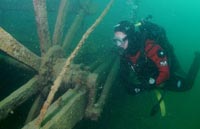 Yukon protects Klondike shipwreck site
Yukon protects Klondike shipwreck site
Just months after a team of archeologists revealed their discovery of a historic Klondike shipwreck in waters north of Whitehorse, the Yukon government has declared the sunken A.J. Goddard sternwheeler a historic site symbolizing the “sense of adventure” that gripped North America at the height of the 1890s gold rush.
In November, famed Canadian wreck hunter James Delgado, his colleague, John Pollack from the Texas-based Institute of Nautical Archaeology, and Yukon museum curator Doug Davidge announced they’d located the “perfectly preserved” Goddard in fabled Lake Laberge, a widening of the Yukon River that served as a key transportation route for gold-seekers in the 1890s.
“The A.J. Goddard is not only a testament to the ingenuity, sense of adventure and determination of those men and women who took part in the Klondike Gold Rush, but also to the key role that the river and sternwheelers played in the economic development of Yukon,” Elaine Taylor, the territory’s tourism and culture minister, said in announcing the wreck’s historical designation.
“The designation of the A.J. Goddard recognizes this small, work-a-day survivor of the Gold Rush as something more than just another shipwreck,” added Delgado, Institute of Nautical Archaeology president and former director of the Vancouver Maritime Museum.
“Preserved as a frozen moment in time in Lake Laberge, the Goddard powerfully speaks to the people who built it, operated it, lived and worked and died on it to make history on the Canadian frontier.”
The designation ensures the wreck site will be protected from recreational divers who might disturb the ship and associated artifacts.
The sternwheeler is known to have gone down with three men in a 1901 storm that swept across the lake, a setting made famous by the Robert Service poem The Cremation of Sam McGee.

What exactly does ‘protected’ mean?
Is it now a restricted site so divers cannot dive the wreck? Do you need a permit? What qualificiations are needed in order to dive it then?